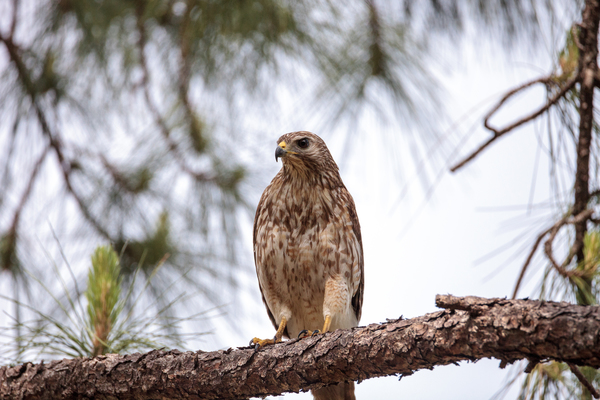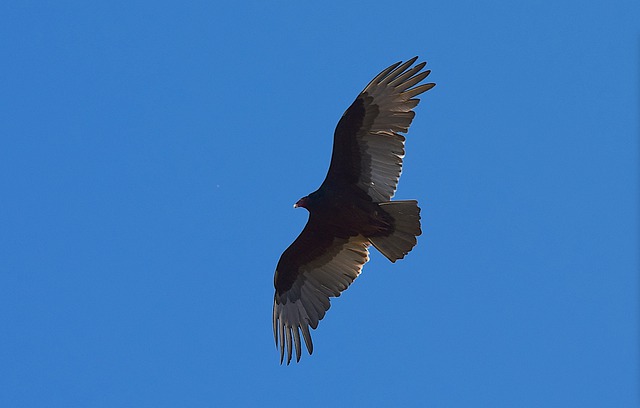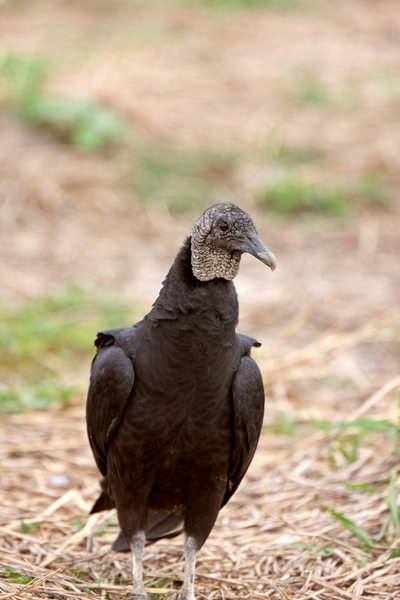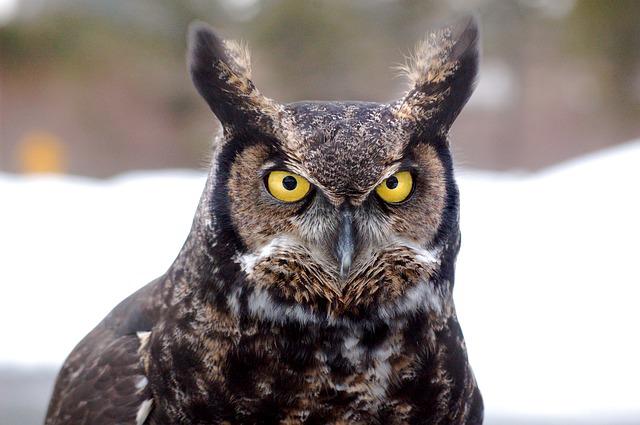Hello, I’m excited to share with you about the majestic birds of prey that call Virginia home!
From soaring eagles to fierce hawks and falcons, these magnificent creatures are a vital part of Virginia’s diverse ecosystem.
In this article, we’ll be exploring 12 different species of birds of prey that you can find in Virginia, including their physical characteristics, habitats, and behaviors.
Whether you’re a seasoned birder or just starting out, there’s something here for everyone to learn and appreciate about these awe-inspiring predators.
So let’s delve into the world of birds of prey in Virginia together!
| Image | Name |
|---|---|
 | Red-Tailed Hawk |
 | Cooper's Hawk |
 | Red-Shouldered Hawk |
 | Broad Winged Hawk |
 | Rough-legged Hawk |
 | Sharp Shinned Hawk |
 | Eastern Screech |
 | Golden Eagle |
 | Bald Eagle |
 | Turkey Vulture |
 | Black Vulture |
 | Great Horned Owl |
Birds of Prey in Virginia
1. Red-Tailed Hawk

The red-tailed hawk may be spotted across the state of Virginia at any time of the year and in any location.
The body and the wings of these hawks appear brown, while their breasts are white and their tails are crimson.
The primary distinction between males and females is the fact that females are about one-third bigger than their male counterparts.
The agricultural fields, meadows, deserts, woodlands, and urban regions of the state are just some of the places where these red-tailed avians may be seen spending their time.
The red-tailed hawk is a predatory bird of prey, meaning that it consumes meat from other animals, including fish, rodents, other birds of a smaller size, and even carrion.
The lifespan of a red-tailed hawk in the wild is estimated to be ranging between 15 to 20 years, however, a captive red-tailed hawk may reach the high end of that range and live for around 20 years.
2. Cooper’s Hawk

Cooper’s Hawks are permanent inhabitants of the state of Virginia, so you will be able to see one almost any time of the year if you go looking for one there.
The rear and top head of Cooper’s hawk appears grey, while the chest, legs, and bottom of the wing have a pattern of orange and white.
Cooper’s hawks may be identified by these characteristics.
The females and males seem to be fairly similar to one another; nevertheless, the females are approximately 35% bigger than the other gender.
It is common to discover a cooper’s hawk in the vicinity of spruces, oaks, pines, beeches, Douglas-firs, and other types of trees.
These hawks prefer to live in deep forests and on level land rather than on steep slopes.
Regarding the food that they consume, the majority of it consists of birds of medium sizes, such as flickers, robins, and jays, in addition to various smaller and even bigger species.
Their diet also includes a variety of other small animals, such as bats, tree squirrels, chipmunks, mice, ground squirrels, and so on.
On average, the lifespan of Cooper’s hawk is somewhere between ten and twelve years, however, the age of the hawk with the longest lifespan on record was over twenty years.
3. Red-Shouldered Hawk

The state of Virginia is home to a population of red-shouldered hawks that remain there throughout the year.
It is possible to identify a red-shouldered hawk by its orange-colored face, chest, and throat, as well as its red-colored shoulders and its dark brown and white striped tail and wings plumage.
The females are around 20 to 30 % bigger than the males, even though their appearance is identical to that of the males.
These hawks may be found in forests that have a mixture of deciduous and coniferous trees and open shrubby areas.
They are most at home in moist woods, especially those that are located in lowlands close to water bodies such as rivers, streams, marshes, and swamps.
These prey birds typically feed on other animals, including mammals, reptiles, frogs, birds, and even crayfish.
It is estimated that a red-shouldered hawk lives between fifteen and Nineteen years on average, however, those kept in captivity have been reported to live for up to 26 years.
4. Broad Winged Hawk

During the time of year when they are breeding, broad-winged hawks may be seen flying over the state of Virginia.
This will frequently cover the period of time from the spring through the summer.
These hawks may be identified by the deeper brown color of their wings, the white and light brown patterning on their chests, the light brown color of their faces, and the yellow color of their legs.
In this context, females and males have a relatively similar appearance, however, females are far larger than males.
In most cases, broad-winged hawks will remain in the vicinity of thick, continuous forests or mixed coniferous and deciduous woodlands.
Amphibians, reptiles, and small mammals, such as toads, voles, mice, snakes, squirrels, frogs, young turtles, and lizards, as well as a wide range of large insects, small birds, and even fish, crayfish, earthworms, and centipedes, are among the foods that they consume.
Their diet consists of a wide range of food sources.
In terms of lifetime, broad-winged hawks have an average life expectancy of twelve years, with the longest broad-winged hawk ever documented having lived for Fourteen years and four months.
5. Rough-legged Hawk

The rough-legged hawk is another kind of prey bird that can only be seen across Virginia during the winter months.
During the summertime, this bird of prey calls the Arctic tundra their home, which explains why its legs are coated in plumage.
Because rough-legged hawks may be seen in two different morphs or color variants, it is far more challenging for a novice birder to correctly identify one of these birds.
The one characteristic that is shared by both the dark and light variants, in addition to the male and female variants, is a thin, vertical line of black pigment that extends from the corner of each eye to the opposite side of their skulls.
Rough-legged hawks of the light variant have white inner plumage showing across their whole bodies, in contrast to the dark morph’s totally dark brown bodies having white or pale underwings.
6. Sharp Shinned Hawk

Virginia is home to year-round populations of sharp-shinned hawks, with the exception of the southeastern region of the Commonwealth, which is the only place in the state where these hawks stay throughout the winter and autumn seasons.
The wings and back of these hawks appear grey, while their breasts and bellies are brown and white, and they possess yellow feet.
Females are around one-third bigger than males while having a fairly similar appearance to males.
There is a good chance of seeing a sharp-shinned hawk in and near open deciduous woods, margins, thickets, and coniferous or mixed forests.
These hawks will typically consume birds ranging in size from that of a sparrow all the way up to that of a robin, and in rare instances, they may even consume birds as large as quails.
In addition to that, they will consume bats, big insects, frogs, squirrels, snakes, and lizards occasionally, as well as rodents.
The average lifespan of a sharp-shinned hawk is between five and six years, however, some individuals may survive for ten years or more if they are provided with the appropriate habitat.
7. Eastern Screech

You ought to have little difficulty seeing eastern screech owls in any part of Virginia at any time of the year.
The mostly grey coloration of the eastern screech owl makes it easy to identify this species.
Females are often bigger than males and have brown-colored feathers on their bodies.
These owls may be encountered in open mixed forests, deciduous forests, parklands, forested suburban areas, riparian woods along wetlands, and streams.
They can also be found in wetlands.
The diet of an eastern screech owl consists of a wide array of meals from different kinds of tiny creatures, such as insects, earthworms, crayfish, lizards, tadpoles, and frogs, as well as birds and mammals.
In the wild, it is estimated that these particular owls may survive for something in the neighborhood of fourteen years at the very most.
8. Golden Eagle

Golden eagles may be seen in the northern part of Virginia when they are not nesting.
Eagles with mostly light brown and dark brown feathers, golden feet, and a black beak that points downwards are easy to identify.
Once again, the females are often the bigger of the two birds, while the males are around 33 percent lower in size.
These eagles spend most of their time on mountains and broad moorlands in places such as Scotland and numerous regions throughout the continent of North America.
Carrion is something that golden eagles will consume, although it is not their primary source of food while they are out hunting.
In the event that they come upon a decaying body, they will consume it; nonetheless, the smaller animals, birds, and sometimes bigger prey make up the majority of their diet.
In the wild, it is believed that these eagles may live for up to fourteen years, but in captivity, they have been known to survive well into their early 30s, with the oldest ever recorded living for 32 years.
9. Bald Eagle

The eastern shore of Virginia is home to bald eagles throughout the year. You may search for them there.
The body and wing plumage of a bald eagle is dark brown, while the feathers on the head and tail are white, and the beak and feet of the bird are yellow—a distinguishing feature.
There is not much of a difference in appearance between a male and female bald eagle.
Eagles of this species are most likely to be seen in the areas near fish-rich reservoirs and lakes, as well as the woodlands that surround such areas.
During the winter season, you can frequently spot them foraging near unfrozen lakes and along the shorelines of coasts, reservoirs, and streams.
These eagles hunt and eat other birds, medium-sized mammals such as hares and rabbits, and other animals such as fish and reptiles, and will even consume carrion if they have no other food alternatives.
Because fish is the only food that bald eagles consume, they are often referred to as fish eagles.
However, because the flesh is the only item that they consume, bald eagles are ultimately considered to be carnivores as well.
In the wild, bald eagles have been known to live for up to twenty years.
10. Turkey Vulture

Turkey vultures are only known to remain in northern Virginia for the duration of the mating season, although they are present throughout the year across central and southern Virginia.
The feathers of turkey vultures are primarily brown or black in color, and they have a silvery or grey line on the inside of their wings, which provides an interesting comparison to their overall look.
The head is mostly black, and the red or pink face is capped with a beak that is a very light shade of white.
The only thing that differentiates these scavengers from one another is their sexual function since they are monomorphic and hence have identical appearance.
There are turkey vultures across North America, and you can find them in open and wooded areas.
They also tend to stick to the lower elevations of mountain ranges when they are in the mountains.
However, turkey vultures will also consume dead birds, reptiles, insects, and amphibians, in addition to carrion being their major source of nutrition.
Vultures, in general, choose fresher carrion, although these particular vultures, like all vultures, are able to devour the same cadaver over the course of many days.
The average lifespan of a turkey vulture in the wild is around sixteen years, however, they may live over thirty years in captivity.
11. Black Vulture

Vultures of the black kind are permanent inhabitants over the whole of the Commonwealth of Virginia.
The bodies of these vultures are nearly totally black, with some grey present on the head and feet.
You can identify them by their appearance.
Since male and female vultures do not exhibit sexually distinct physical characteristics, it may be difficult to determine which one is which.
The majority of black vultures will spend their time at lower altitudes, even though they may be seen living in both wooded and open regions throughout the year.
Carrion is the main source of nutrition for vultures, which is consistent with their natural behavior, given that they are scavengers.
Even though they prefer to eat fresh corpses, they are capable of eating the same carcass many times over the course of several days.
On rare occasions, black vultures may hunt live prey, however, most of the time, the live prey they pursue, whether it be mammals or birds, is sick or weak, making it simpler for them to capture.
When it comes to longevity, black vultures in the wild have an average life expectancy of around ten years, but captive ones have the potential to live for up to thirty years.
12. Great Horned Owl

The Great Horned Owl is a year-round resident of the Virginia Commonwealth.
Large horned owls are distinguished by their brownish-gray appearance and the tuft of the feather that sits atop their heads and resembles a horn or ear.
Great horned owls, both sexes, seem similar, with the female being somewhat bigger than the male.
These birds sit on a tree or a high building at night and search the area for potential prey.
When they see anything they like, they swoop towards it with their wings folded, grasp it with their talons, and usually kill it instantly.
Smaller animals such as scorpions, rats, and frogs are among the food items consumed by these birds.
These predatory birds will consume everything from insects to other birds, including bigger predators such as hawks, ducks, geese, and even smaller owls.
The great horned owl is a frequent resident in semi-open habitats between the Arctic and the tropics, including gardens, ponds, deserts, woods, towns, and grasslands.
The average lifetime of a great horned owl is between fifteen and twenty-five years.
Conclusion
In conclusion, Virginia is home to a wide variety of fascinating birds of prey, each with their own unique characteristics and behaviors.
From the impressive wingspan of the Bald Eagle to the swift hunting abilities of the Cooper’s Hawk, these magnificent birds are a testament to the wonders of nature.
As apex predators, birds of prey play a crucial role in maintaining a healthy and balanced ecosystem, and their presence is a source of inspiration and awe for people of all ages.
Whether you’re an experienced birder or a casual observer, Virginia’s birds of prey offer endless opportunities for learning, discovery, and appreciation.
So the next time you’re out in nature, keep an eye out for these remarkable creatures and take a moment to marvel at their incredible adaptations and beauty.
With their grace, power, and majesty, birds of prey are truly one of Virginia’s most treasured natural wonders.
FAQ
Where do birds of prey live in Virginia?
Birds of prey can be found in a variety of habitats throughout Virginia, including forests, grasslands, wetlands, and suburban areas.
Are birds of prey endangered in Virginia?
Some species of birds of prey in Virginia, like the Bald Eagle, were once endangered but have since made a recovery thanks to conservation efforts. However, habitat loss, pollution, and other factors can still threaten their populations.
Are birds of prey dangerous to humans?
While birds of prey are powerful predators, they typically pose no threat to humans unless they feel threatened or cornered. It’s important to respect their space and avoid disturbing their nesting sites.
Can I attract birds of prey to my backyard?
While it’s not common to attract birds of prey to a backyard, you can encourage their presence by providing food and habitat for their prey species, such as mice and voles.
Can I legally hunt birds of prey in Virginia?
No, it is illegal to hunt birds of prey in Virginia or anywhere in the United States. Many birds of prey are protected by federal and state laws.
Last Updated on May 15, 2023 by Lily Aldrin

These eagles hunt and eat other birds, medium-sized mammals such as hares and rabbits, and other animals such as fish and reptiles, and will even consume carrion if they have no other food alternatives.
Because fish is the only food that bald eagles consume, they are often referred to as fish eagles.
However, because the flesh is the only item that they consume, bald eagles are ultimately considered to be carnivores as well.
THEY EAT OTHER ANIMALS, YET FISH IS THE ONLY FOOD THEY CONSUME??? FLESH IS THE ONLY ITEM…CARNIVORES AS WELL??? YOU GOT THIS PUBLISHED???